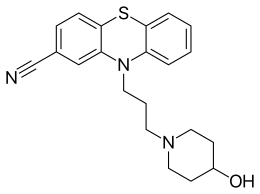Periciazine
Periciazine (INN), also known as pericyazine (BAN) or propericiazine, is a drug that belongs to the phenothiazine class of typical antipsychotics.
 | |
| Clinical data | |
|---|---|
| Pregnancy category |
|
| Routes of administration | Oral |
| ATC code | |
| Legal status | |
| Legal status | |
| Pharmacokinetic data | |
| Metabolism | Hepatic (mostly via conjugation)[1] |
| Elimination half-life | 12 h[1] |
| Excretion | Renal[1] |
| Identifiers | |
IUPAC name
| |
| CAS Number | |
| PubChem CID | |
| DrugBank |
|
| ChemSpider |
|
| UNII | |
| KEGG |
|
| ChEBI | |
| ChEMBL | |
| CompTox Dashboard (EPA) | |
| ECHA InfoCard | 100.018.248 |
| Chemical and physical data | |
| Formula | C21H23N3OS |
| Molar mass | 365.49 g/mol g·mol−1 |
| 3D model (JSmol) | |
SMILES
| |
InChI
| |
| | |
Pericyazine is not approved for sale in the United States. It is commonly sold in Canada and Russia under the tradename Neuleptil and in United Kingdom and Australia under the tradename Neulactil.[2]
Medical uses
The primary uses of pericyazine include in the short-term treatment of severe anxiety or tension and in the maintenance treatment of psychotic disorders such as schizophrenia. There is insufficient evidence to determine whether periciazine is more or less effective than other antipsychotics.[1] A 2014 systematic review compared pericyazine with typical antipsychotics for schizophrenia:
| Summary | ||||||||||||||||||||||||||||||||||||
|---|---|---|---|---|---|---|---|---|---|---|---|---|---|---|---|---|---|---|---|---|---|---|---|---|---|---|---|---|---|---|---|---|---|---|---|---|
| On the basis of very low quality evidence it is not possible to determine the effects of pericyazine in comparison with antipsychotics such as chlorpromazine or trifluoperazine for the treatment of schizophrenia. There is some evidence, however, that pericyazine may be associated with a higher incidence of extrapyramidal side effects than other antipsychotics.[3] | ||||||||||||||||||||||||||||||||||||
| ||||||||||||||||||||||||||||||||||||
Periciazine has also been studied in the treatment of opioid dependence.[4]
Adverse effects
Pericyazine is a rather sedating and anticholinergic antipsychotic, and despite being classed with the typical antipsychotics, its risk of extrapyramidal side effects is comparatively low.[5] It has a relatively high risk of causing hyperprolactinaemia and a moderate risk of causing weight gain and orthostatic hypotension.[5]
References
- "NEULACTIL PRODUCT INFORMATION" (PDF). TGA eBusiness Services. sanofi-aventis australia pty ltd. 13 September 2011. Retrieved 2 November 2013.
- Pericyazine. Martindale: The Complete Drug Reference. The Royal Pharmaceutical Society of Great Britain. 23 September 2011. Retrieved 2 November 2013.
- Matar, H; Almerie, M; Makhoul, S (2014). "Pericyazine for schizophrenia". Cochrane Database of Systematic Reviews. 5: CD007479.pub2. doi:10.1002/14651858.CD007479.pub2.
- Sivolap IuP, Savchenkov VA (1999). "[The use of neuroleptics in treating opiate dependence]". Zh Nevrol Psikhiatr Im S S Korsakova (in Russian). 99 (6): 29–34. PMID 10441864.
- "Approximate relative frequency (not intensity) of common adverse effects of antipsychotics (Table 8.21) [NB1]". eTherapeutic Guidelines complete. Therapeutic Guidelines Limited. February 2013. Retrieved 2 November 2013.
External links
- Neulactil - Summary of Product Characteristics from the electronic Medicines Compendium
- from the Therapeutic Goods Administration.
- from Health Canada.
| Typical |
|
|---|---|
| Disputed | |
| Atypical |
|
| Others | |
| |
| Classes |
|
|---|---|
| Antidepressants (TCAs and TeCAs) |
|
| Antihistamines |
|
| Antipsychotics |
|
| Anticonvulsants | |
| Others |
|